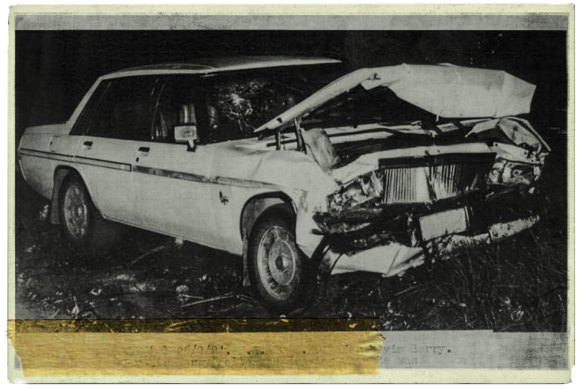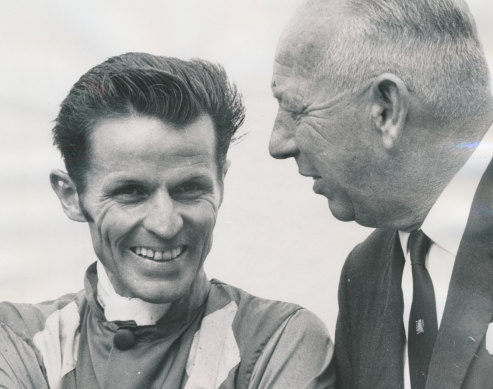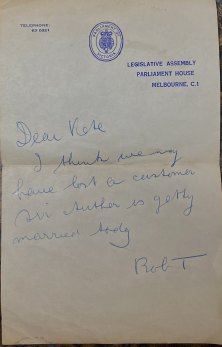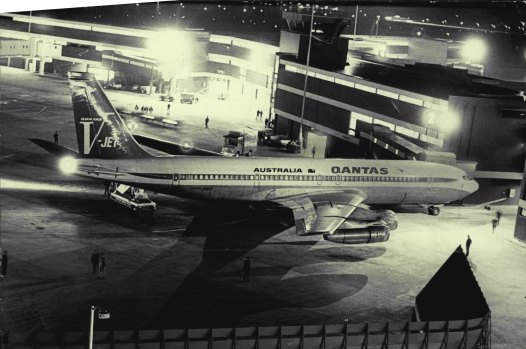- Analysis
- National
- Victoria
- Naked City
This was published 3 years ago
Cars, crashes and cover-ups: five unsolved scandals from Victoria
If politician Tim Smith had planned a crash or crash through career (before he crashed at more than twice the legal limit), then he failed to live up to the spiritual example of the ultimate conservative hard nut, former Victorian premier Sir Henry Bolte: Deny everything.
Bolte was a law-and-order man (he succeeded in hanging Ronald Ryan, the last man executed in Australia) although Sir Henry thought that in his own case, the law should bend to his orders.
While his government had been at the forefront of road safety initiatives, including introducing compulsory front-seat safety belts, Bolte was a man of habit and driving home full of scotch was one of them. Which is why he makes the list of this reporter’s top five unresolved scandals.
Bolte’s bolt of luck
Twelve years after his 1972 retirement as Victoria’s longest-serving premier, Sir Henry had a head- on crash near his farm. While logic suggested he should be sent to the Geelong Hospital, rat cunning required him to go to the Ballarat Hospital, where he had many friends.
Despite his initial protest, blood was taken to be tested for alcohol, and as usual split into three samples: one to be tested at the spot, a second to be sent to forensic for a test to be used in court and a third to be given to the injured driver.

Statesman Sir Henry Bolte’s banged-up Statesman.Credit: Kevin John Berry
The first sample was said to be nearly three times the limit, but the two remaining samples were substituted and the evidence box left unlocked, meaning Sir Henry got away with it, unlike the driver of the other car, who suffered life-altering injuries.
Bolte always said he was not involved in any conspiracy: “Of course I know nothing, I was unconscious.”
Tim Smith will suffer the legal, professional and financial consequences where, not so long ago, those in power were often seen to be above the law. For those of us who still have the energy to be outraged at one public scandal or another, let’s remember a time when a pinstripe suit was much less likely to be replaced by a striped prison one.
The offside offsider
Back in the 1950s, before legal off-course betting, there were thousands of SP bookmakers in back lanes and pubs. Then there were the Big Eight - the illegal bookmakers that set the market and controlled much of the industry.
One of the most enthusiastic punters was deputy premier and chief secretary Sir Arthur Rylah, who had the perfect betting system: If he won he would be paid; if he lost he would not be charged.

Then deputy premier Sir Arthur Rylah (right) being amusing with jockey J.J. Miller in 1969. No wonder Miller is laughing.Credit: The Age
Perhaps that was why the government wasn’t that keen to change the system. Certainly, his bookie (one of the Big Eight) was always welcome to park his car in the Parliament compound with a wave to the guard. No one knows if it was bravado or he had the unofficial keys to the city.

The day the SP bookmaker lost the deputy premier as a client.Credit: John Silvester’s crime museum
When the bookie died, among his possessions was a note to his partner: “I think we may have lost a customer. Sir Arthur is getting married today.”
It is on Parliament letterhead.
This would be Sir Arthur’s second marriage, on October 9, 1969, to his long-term mistress.
His first wife, Lady Ann Rylah, author and Girl Guide commissioner, had died seven months earlier. She was found unconscious in the back garden of her sprawling Kew home with a head wound. She and Sir Arthur had separated months earlier.
Lady Ann was a vet who would usually put her work boots on at the back door. This time she apparently walked several metres past the shoes and was in her socks and vet’s uniform when she collapsed.
Homicide quickly found there were no suspicious circumstances. A post-mortem by pathologist James “Mack the Knife” McNamara found death was from a brain hemorrhage.
There are many who believe the bleed came from a heavy blow from a garden spade. No one seemed to wonder why she was shoeless while apparently heading to the kennels at the rear.
The cremation was held four days later. The homicide officer assigned was Detective Inspector Jack Ford - also a prodigious punter.
I once asked a homicide squad detective of that era about the case. He paused, then said it was handled by Ford’s best friend: “There was not much paperwork.”
At the time there was growing evidence some members of the homicide squad were being paid bribes by abortionists. Sir Arthur opposed an inquiry for years.
In 1970 he reluctantly announced a judicial inquiry under William Kaye, QC, with very narrow terms of reference. The following January Sir Arthur announced his resignation before the inquiry’s findings were tabled.
The Kaye Inquiry found a corrupt system of payments to some in the squad. Ford, his boss Superintendent Jack Matthews, and former detective constable Martin Jacobson were jailed.
There was another side to Sir Arthur. In 1963 my father Fred, a policeman, was in Hong Kong extraditing a corrupt lawyer when he ran into Sir Arthur and Lady Ann on the steps of Government House just before Christmas.
“What are you doing here?” Sir Arthur asked. When Fred explained, Sir Arthur told him: “Get home for Christmas to see your family.”
Fred baulked, predicting the government wouldn’t pay for a second trip to get the suspect.
Sir Arthur promised he would. And, unlike the bookies’ promissory notes, this time he kept his word. My father came home and I was presented with a battery-operated Qantas Boeing 707 with flashing lights and operational stairs.

A Qantas Boeing 707.Credit: Staff photographer
Getting caught with your pants down
Before Tom (No) Blamey became Australia’s only homegrown field marshal, he was Victoria’s chief commissioner of police from 1925 to 1936, with a habit of misplacing both the truth and his trousers.
On October 21, 1925, three police raided Mabel Tracey’s brothel in Bell Street, Fitzroy, to be greeted by a naked gentleman flashing (among other things) police identification, calmly declaring: “That is all right boys. I am a plainclothes constable. Here is my badge.”
The badge was numbered 80 - Tom Blamey’s. He claimed it had been stolen from his keyring and then dropped three days later at his Naval and Military Club letterbox. Despite his deputy saying he saw it on the chief’s desk hours before the raid, No-Blamey survived.
Ten years later, when the head of the criminal investigation bureau, Superintendent John Brophy, was shot in his car in the company of two lady friends, Blamey enthusiastically joined the cover-up.
The first version was that he “was accidentally shot in the right arm whilst handling his revolver”. Yet he was also shot in the cheek and chest (he survived because one shot deflected off the buckle of his braces).
When the accidental wounding story failed to fly, Blamey declared Brophy was shot on his way to meeting an informer as part of armed robbery investigations. Yet there was no manhunt.
The good mail was that Brophy was shot by a jealous husband while Blamey was in the back seat, sans trousers.
The cop with the secret past
In the 1950s a teenage schoolboy was skipping home through a bayside car park which older men frequented for sinister purposes. Sure enough the boy was invited into a parked dark Buick sedan, where he was molested.
The boy was assaulted several more times in the man’s small St Kilda flat.
Nearly 40 years later the boy was a man who had graduated to a position of power and status, so much so that he was invited to a formal police dinner with other movers and shakers. From the walls of the function room photos of some of Victoria’s most respected cops looked down. One was the man in the Buick.
The ‘green light’ murder
When the man with the beard stood up and shot notorious armed robber Ray “Chuck” Bennett on November 12, 1979, in front of police and inside the old Melbourne Magistrates’ Court, he knew exactly what he was doing and where he was going. According to one insider, this was because the killer had been smuggled into the court complex a day before - hidden in the boot of a cleaner’s car by two detectives for a dress rehearsal.
The court was a maze of corridors and doors not accessed by the public - yet the killer ran directly to an internal carpark hidden from the street to a corrugated fence where the tin had been peeled back for his escape.
The number one suspect was gangster Brian Kane, who wanted revenge on Bennett after he and two other men were acquitted of killing Brian’s brother, Les.
As one detective of the time told me: “We decided to stick with the Kanes, not because of the Kanes themselves but because they were more predictable, they had rules, they caught and killed their own and looked after their own.
“About two in the afternoon an informer told Angus [Detective Senior Sergeant Angus Ritchie, chief of the consorting squad] ‘it was an inside job from your office’.”
Brian Kane was shot dead in Brunswick’s Quarry Hotel in 1982. His murder remains unsolved.